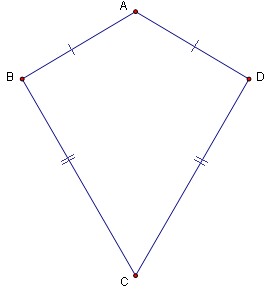 |
| 1 |  | 
Note: Use grid paper and/or dynamic geometry software to help you in this quiz.  <a onClick="window.open('/olcweb/cgi/pluginpop.cgi?it=jpg::::/sites/dl/free/0070973199/362685/pom9_ch7_sec5_quiz1_ques1.jpg','popWin', 'width=NaN,height=NaN,resizable,scrollbars');" href="#"><img valign="absmiddle" height="16" width="16" border="0" src="/olcweb/styles/shared/linkicons/image.gif"> (7.0K)</a> <a onClick="window.open('/olcweb/cgi/pluginpop.cgi?it=jpg::::/sites/dl/free/0070973199/362685/pom9_ch7_sec5_quiz1_ques1.jpg','popWin', 'width=NaN,height=NaN,resizable,scrollbars');" href="#"><img valign="absmiddle" height="16" width="16" border="0" src="/olcweb/styles/shared/linkicons/image.gif"> (7.0K)</a>
Quadrilateral ABCD is a kite, with equal sides as shown. E is the midpoint of AB, F is the midpoint of BC, G is the midpoint of CD, and H is the midpoint of DA. Which of these is (are) true? |
|  | A) | EH || FG |
|  | B) | EF || HG |
|  | C) | AB || DC |
|  | D) | All of these are true. |
|
|
 |
| 2 |  | 
What kind of quadrilateral is EFGH? |
|  | A) | square |
|  | B) | rhombus |
|  | C) | parallelogram |
|  | D) | all of these |
|
|
 |
| 3 |  | 
Is angle EFG always obtuse, acute, or a right angle for a kite? |
|  | A) | It depends on the dimensions of the original kite ABCD. |
|  | B) | obtuse |
|  | C) | acute |
|  | D) | right angle |
|
|
 |
| 4 |  | 
How does the area of the kite ABCD relate to the area of EFGH? |
|  | A) | It depends on the dimensions of the original kite ABCD. |
|  | B) | 2:1 |
|  | C) | 3:1 |
|  | D) | 4:1 |
|
|
 |
| 5 |  | 
Johann conjectures that any diagonal of a quadrilateral always bisects the area. |
|  | A) | This is always true. |
|  | B) | This is true only if the quadrilateral is a square. |
|  | C) | This is true only if the quadrilateral is a rhombus. |
|  | D) | This is true only if the quadrilateral is a parallelogram. |
|
|

